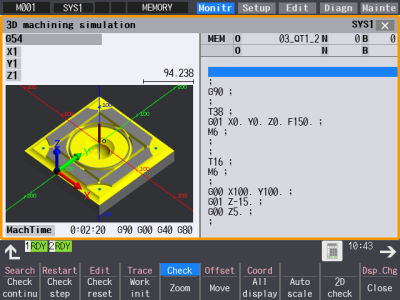
As part of its e-F@ctory Digital Manufacturing initiative, Mitsubishi Electric is partnering with ModuleWorks to integrate the ModuleWorks machine simulation software into its CNC controls. The technology partnership enables users on the shop floor to benefit from powerful 3D graphical simulation with full-scene collision detection.
“The ModuleWorks simulation is part of our strategy of leveraging strong technology partnerships that add value to our numerical control equipment and enable us to continuously deliver the latest technology to our customers in the shortest time” says the NC-System Department at Mitsubishi Electric.
Integrated directly into the HMI, ModuleWorks machine simulation enhances the Mitsubishi controls with high-performance multi-axis milling and turning simulation including gouge and deviation analysis and collision detection with manual or automatic refinement of the simulation result. Workpiece coloring according to the sequence provides convenient visual analysis and enables operators to immediately identify and prevent potential collisions for safe and cost-effective machining.
“It’s great to see how our technology takes leading CNC manufacturers like Mitsubishi Electric a step further in their digital manufacturing strategies to improve machining performance, efficiency and safety”, says Mark Foti, Head of Digital Factory at ModuleWorks. “We look forward to a continued successful partnership and new technological developments.”
In the next stage of the cooperation, the two companies are extending the simulation with ModuleWorks collision avoidance logic that automatically chooses the best way to handle the detected collisions.
Contact Details
Contact Details
Related Glossary Terms
- computer numerical control ( CNC)
computer numerical control ( CNC)
Microprocessor-based controller dedicated to a machine tool that permits the creation or modification of parts. Programmed numerical control activates the machine’s servos and spindle drives and controls the various machining operations. See DNC, direct numerical control; NC, numerical control.
- gang cutting ( milling)
gang cutting ( milling)
Machining with several cutters mounted on a single arbor, generally for simultaneous cutting.
- milling
milling
Machining operation in which metal or other material is removed by applying power to a rotating cutter. In vertical milling, the cutting tool is mounted vertically on the spindle. In horizontal milling, the cutting tool is mounted horizontally, either directly on the spindle or on an arbor. Horizontal milling is further broken down into conventional milling, where the cutter rotates opposite the direction of feed, or “up” into the workpiece; and climb milling, where the cutter rotates in the direction of feed, or “down” into the workpiece. Milling operations include plane or surface milling, endmilling, facemilling, angle milling, form milling and profiling.
- numerical control ( NC)
numerical control ( NC)
Any controlled equipment that allows an operator to program its movement by entering a series of coded numbers and symbols. See CNC, computer numerical control; DNC, direct numerical control.
- turning
turning
Workpiece is held in a chuck, mounted on a face plate or secured between centers and rotated while a cutting tool, normally a single-point tool, is fed into it along its periphery or across its end or face. Takes the form of straight turning (cutting along the periphery of the workpiece); taper turning (creating a taper); step turning (turning different-size diameters on the same work); chamfering (beveling an edge or shoulder); facing (cutting on an end); turning threads (usually external but can be internal); roughing (high-volume metal removal); and finishing (final light cuts). Performed on lathes, turning centers, chucking machines, automatic screw machines and similar machines.


